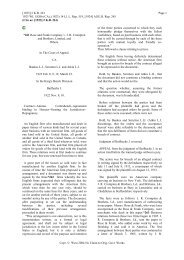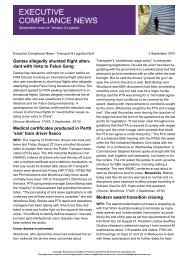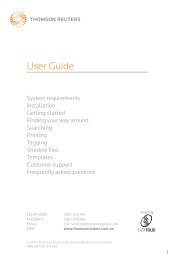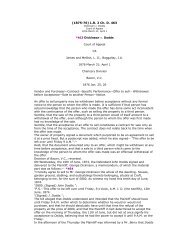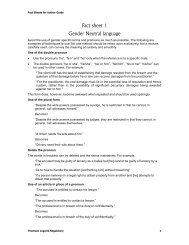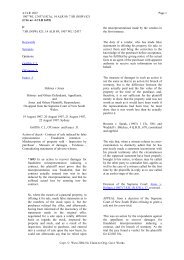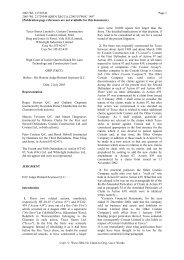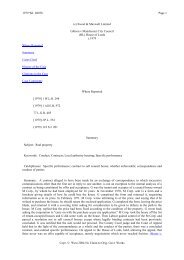147Ch <strong>23</strong>: <strong>Product</strong> <strong>Liability</strong>The only legitimate function that this distinction serves is to focus attentionon the fact that, whereas liability for a defectively made article is primarily basedon negligence in causing the defect, 101 the hazard peculiar to inherentlydangerous commodities stems from failure to give notice of the danger. In otherwords, the negligence, if any, is associated with the distributive rather than themanufacturing process. Unfortunately, this aspect was obscured when thecategory of things dangerous per se emerged in mid 19th century 102 as a ployfor narrowing the immunity afforded by the privity rule to manufacturers ofnegligentlydefective products. Henceforth, a duty of care was demanded for themanufacture of dangerous things, though not yet of products ordinarilyharmless unless negligently made. Donoghue v Stevenson eventually dispensedwith this devious use of the category, though an analogous function in limitingthe liability of contractors and landlords for negligent installations actuallysurvived for another 25 years. 103 Its only remaining significance in this respectis a reminder that, though no longer a determinant of duty, inherently dangerousthings may yet call for more in the way of fulfilling that duty, commensuratewith their aggravated risk. 104Thus the degree of requisite diligence has been variously described asamounting “practically to a guarantee of safety”, 105 requiring the observance of“consummate care”, 106 “approaching, even if it does not attain, strict orabsolute liability”. 107 A warning would not be sufficient unless it is given to acompetent person and is adequate to acquaint him or her fully with thedangerous properties of the substance so that he or she can adopt suitableprecautions to prevent the product from becoming a source of injury toanyone. 108But however strict, liability is not completely unqualified and requires someshowing of fault, however slight. 109 Some substances, like explosives andpoison, can never be made entirely safe and protected from every conceivableinterference by extraneous elements. In such cases, the duty ought to beER 629), a catapult (Smith v Leurs (1945) 70 CLR 256 at 259), a long-spouted can (Wray vEssex CC [1936] 3 All ER 97), a locked sedan with a dog inside it (Fardon vHarcourt-Rivington (1932) 48 TLR 215), and a domestic steam boiler: Ball v LCC [1949] 2KB 159.101 In exceptional cases it may also be based on failure to detect a defect by reasonableinspection.102 Longmeid v Holliday (1851) 6 Ex 761; 155 ER 752.103 Billings (AC) v Riden [1958] AC 240.104 DonoghuevStevenson [1932] AC 562 at 596;TodmanvVictaLtd [1982] VR 849;BeckettvNewalls [1953] 1 WLR 8 at 15; Rae v Eaton Co (1961) 28 DLR (2d) 522.105 Donoghue v Stevenson [1932] AC 562 at 612 per Lord Macmillan. This has been repeatedlyendorsed, for example, Ayoub v Beaupre [1964] SCR 448 at 451; Adelaide Chemical Co vCarlyle (1940) 64 CLR 514 at 5<strong>23</strong> per Starke J; Burnie PortAuthority v General Jones PtyLtd (1994) 179 CLR 520 at 554 per Mason CJ, Deane, Dawson, Toohey and Gaudron JJ.106 Adelaide Chemical Co v Carlyle (1940) 64 CLR 514 at 522-5<strong>23</strong> per Starke J.107 Hackshaw v Shaw (1984) 155 CLR 614 at 630 per Murphy J.108 CompareNortonvStreetsIceCream (1968) 120 CLR 635 (“highly inflammable” sufficient)with Lambert v Lastoplex [1972] SCR 569 (insufficient). Also Streets Ice Cream vAustraliaAsbestos [1967] 1 NSWR 50;AndersonvEnfieldCityCorp (1983) 34 SASR 472 (“caution”held to be too mild a warning). <strong>Product</strong>s for the retail market should carry prominentwarning on their labels, but if for specialist use only, like hair dye supplied to hairdressers, itis sufficient to warn the latter alone and rely on them to take the directed precautions:Holmes vAshford [1950] 2 All ER 76.109 Hercules Textile Mills v K & H Textile Engineers [1955] VLR 310 at 313; Todman v VictaLtd [1982] VR 849. The dangerous nature of the article, if not notorious, must have beenknown to the defendant:ImperialFurniturevAutomaticFireSprinklers [1967] 1 NSWR 29.DRAFTsession: 5 October 28, 2010 page no: 12 folio no: 147@syd-tlrapp-p19/syd-tlrapp-p191/CLS_law/GRP_flemings/JOB_update10/DIV_19PROOF COPY
Negligence 148regarded as discharged if the custodian selects a method of storing which, so faras humanly possible, eliminates the danger of explosion and reduces to aminimum the possibility that persons unacquainted with its dangerous charactercould gain access to it. Yet how exacting the standard is in practice isdramatically illustrated by a New Zealand decision 110 which declined to excusea defendant for storing detonators in a metal box on a high shelf in a darkcorner of a disused house on an isolated farm, when a labourer who took shelterthere from the rain on his way to work cleaned out the detonator in ignorance ofits nature and was killed by an explosion.Nor is the duty in cases such as these owed only to persons who unwittinglypick up the explosive or perhaps those who are injured in the immediate vicinity.It has been held to be foreseeable, for example, that teenagers might break intoan insufficiently secured safe in an open quarry containing detonators and,unaware of the risk, give them to another child who inadvertently sets off anexplosion after having taken them home. 111Responsibility for taking precautions rests not only on the manufacturer ofthe highly dangerous product but on everyone alike who transfers it to anotheror has custody or control over it. 112 Here, at any rate, it is irrelevant that thedefendant is only a gratuitous bailor, donor 113 or mere distributor who has nothimself increased the hazard inherent in the object beyond creating anopportunity where it might cause harm to others, as when a shopkeeper sold adangerous toy pistol to a child of 12 who injured a companion with blankammunition. 114 The nature of a product such as a gun leads to a duty thatrequires the person in control of the gun to take care as to the persons allowed touse the gun. 115Manufacturers and other suppliers[<strong>23</strong>.90] The responsibility laid upon manufacturers by Donoghue v Stevensonhas been progressively extended to makers of component parts integrated into afinal product by someone else, 116 to repairers, 117 repackagers, 118 erectors, 119assemblers, 120 and modifiers. 121 Beyond that, reasonable care demands fromthose handling or distributing goods some measure of inspection to detectdefects in the creation of which they may not have had a hand at all. The makerDRAFT110 Marcroft v Inger [1936] NZLR 121. But a trespasser was disqualified in Clayton v Victoria[1968] VR 562 (sulphuric acid in school laboratory).111 McCarthy v Wellington City [1966] NZLR 481 (CA); Holian v United Grain (1980) 112DLR (3d) 611.112 See, for example, Rivett Arboricultural & Waste Equipment Hire Pty Ltd v Evans [2007]SASC 108 (FC) (duty owed by owner of wood-chipping machine as well as by manufacturer).113 See Ball v LCC [1949] 2 KB 159. In relation to food donors see n 147.114 Burfitt v Kille [1939] 2 KB 743.115 John Pfeiffer Pty Ltd v Canny (1981) 148 CLR 218 at 241 per Brennan J.116 Evans v Triplex Glass [1936] 1 All ER 283 at 286 (windscreen).117 HaseldinevDaw [1941] 2 KB 343;JullvWilson [1968] NZLR 88;Godfrey’svRyles [1962]SASR 33. But the repairer may well have been justified in relying on an intermediateexamination.118 Glendale Chemical <strong>Product</strong>s Pty Ltd vACCC (1998) 90 FCR 40 (FC).119 Brown v Cottrill (1934) 51 TLR 21.120 Stennett v Hancock [1939] 2 All ER 578; Howard v Furness Houlder [1936] 2 All ER 781;Malfroot v Noxal (1935) 51 TLR 551.121 Stillwell Trucks v McKay [2002] NSWCA 292.session: 5 October 28, 2010 page no: 13 folio no: 148@syd-tlrapp-p19/syd-tlrapp-p191/CLS_law/GRP_flemings/JOB_update10/DIV_19PROOF COPY



